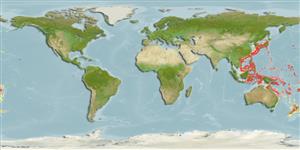Common names from other countries
Holocephali (quimeras) (chimaeras) >
Chimaeriformes (Chimaeras) >
Chimaeridae (Shortnose chimaeras or ratfishes)
Etymology: Chimaera: Named for the mythological creature composed of parts of multiple animals, referring to their odd mix of characteristics. (See ETYFish); phantasma: Greek for phantom or apparition, probably referring to its striking appearance in life (silvery, with jet-black bands down the sides) and/or overall ghoulish appearance common to all chimaeras. (See ETYFish).
More on authors: Jordan & Snyder.
Environment: milieu / climate zone / depth range / distribution range
Ecologia
marinhas batidemersal; intervalo de profundidade 90 - 540 m (Ref. 9904). Deep-water
Western Pacific: Japan, Korea, China, Taiwan, and the Philippines.
Tamanho / Peso / Idade
Maturity: Lm ? range ? - ? cm
Max length : 100.0 cm TL macho/indeterminado; (Ref. 637); common length : 60.0 cm TL macho/indeterminado; (Ref. 9137)
Found in continental shelves and upper slopes (Ref. 9904, 11230); shelf edge, 60-550 m (Ref. 11230). Feeds mainly on small benthic animals (Ref. 637). Oviparous (Ref. 205). Eggs are encased in horny shells (Ref. 205). Used in Chinese medicine (Ref. 12166). Caught with bottom trawls but utilization uncertain except as fish balls (kamaboko) in Japan (Ref. 9904).
Ciclo de vida ou comportamento de acasalamento
Maturities | Reprodução | Spawnings | Egg(s) | Fecundities | Larvas
De la Paz, R.M. and R. Interior, 1979. Deep-sea fishes off Lubang Island, Philippines. Nat. Applied Sci. Bull. 31(3-4):175 p. (Ref. 5282)
Status na Lista Vermelha da UICN (Ref. 130435)
CITES (Ref. 128078)
Not Evaluated
Ameaça para os humanos
Harmless
Uso pelos humanos
Pescarias: espécies comerciais
Ferramentas
Relatórios especiais
Baixar XML
Fontes da internet
Estimates based on models
Preferred temperature (Ref.
115969): 8.4 - 21.7, mean 15.9 (based on 203 cells).
Índice de diversidade filogenética (Ref.
82804): PD
50 = 0.5000 [Uniqueness, from 0.5 = low to 2.0 = high].
Bayesian length-weight: a=0.00282 (0.00118 - 0.00673), b=3.10 (2.89 - 3.31), in cm Total Length, based on LWR estimates for this (Sub)family-body shape (Ref.
93245).
Nível Trófico (Ref.
69278): 3.5 ±0.42 se; based on food items.
Resiliência (Ref.
120179): Baixo, tempo mínimo de duplicação da população 4,5 - 14 anos (Assuming Fec <100).
Fishing Vulnerability (Ref.
59153): High vulnerability (60 of 100).
